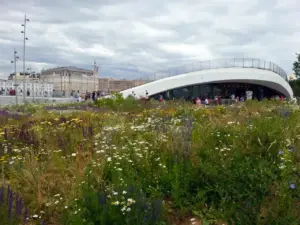Damascus. The name itself sounds like an echo of millennia. The capital of Syria, the oldest continuously existing capital in the world, whose history dates back to the 4th millennium BC
A phoenix city whose image has been molded, erased and molded again over the centuries - from blossoming to oblivion, from deep sleep to a new awakening. But through all the storms of time it remained unshaken: an eternal oasis in the desert, the center of faith and the pulsating heart of life, the keeper of the memory of victories and defeats, masterpieces of great masters and the breath of bygone eras.
Damascus is located in the legendary green shield, spreading 25 kilometers from north to south and 16 kilometers from west to east. It is the child of a wayward river Al-Barada, "Cold."bringing life-giving coolness from the Lebanese mountains. Her 40-kilometer channel - the lifeline that creates the "second paradise", the oasis of Ghouta, amidst the Syrian deserts. Even today, despite the difficulties of recent years, the hardships of hardship and the not fully restored fertile land and the famous rose plantations, Ghouta remains a symbol of resilience.
A strategic crossroads, fertile land, water and wealth have magnetically attracted conquerors of all eras. From the Assyrians and Persians to Alexander the Great, the Romans, the Arabs, the Crusaders, the Mongols and the Ottomans, the list of those who dreamed of conquering Damascus reads like a world history textbook. Some have left a deep mark on the city's stone and fate, others have faded into oblivion. But Damascus, like its ancient walls, endured.
Today, after more than a decade of complex conflict, the city is revitalized, life is returning to its streets, and monument restoration efforts have become a symbol of national revival.
The heart of Damascus beats in Umayyad Square, where the towering The Great Umayyad Mosque - an architectural confession of the ages. Built on the site of a Roman temple of Jupiter and a Byzantine church St. John the Baptist (379-396)The mosque has survived six devastating fires in the last millennium, but each time it has been rebuilt even more beautifully. After restoration work intensified in recent years, the mosque is now open again to worshippers and visitors. Here, in a chapel revered by Muslims and Christians alike Yahya (John the Baptist).The head of the saint, a unique symbol of the intertwining of religions.
Not far away Damascus Citadel (Al-Qalaa) - a mighty stronghold founded by the legendary Salah al-Din (Saladin). in the twelfth century. Although its walls remember Crusader and Mongol attacks, extensive restoration projects supported by international organizations (including UNESCO) and the Syrian authorities are gradually restoring the citadel to its former glory. At the foot of the citadel is the Mausoleum of Saladin. The marble sarcophagus, donated by Kaiser Wilhelm II in 1898, is juxtaposed with the hero's original tomb, which is much more modest but full of oriental dignity.
The mind and spirit of the city has been nurtured for centuries in its madrasas. Al-Adiliya Madrasa (1218)Named in honor of Saladin's brother, it now serves as the presidium of the Arab Academy of Sciences, preserving knowledge. The al-Zahiriyya Madrasa (1277), associated with the Mamluk Sultan Beibars, continues to educate as a public library despite the vicissitudes of modern times.
The jewel of the Ottoman era remains. Azem Palace (Beit al-Azm)built in 1750. This masterpiece, turned into a museum of the traditions and history of Damascus, survived the bombings. After renovation, it has reopened its doors, offering a world of cool courtyards, elegant inlays, whispering fountains and fragrant gardens. Located in the heart of the old Al Hamidiya souks (which are also being actively restored and re-invigorated), the palace is a true "haven of quiet beauty".
It is deeply symbolic that the land that keeps Damascus cool and alive has long been known as the "Paradise of God", fragrant with Damascus roses. Today, those roses, a symbol of resilience and hope, are beginning to bloom again in Ghouta, marking the slow but persistent return to peace and normalcy.
And as the plane rounds the mountain on approach. KasiyunIn the window, the same eternal and ever-changing view reappears: the dark green of Ghouta's gardens, the emerald domes of mosques, and the warm amber of the lights in the residential neighborhoods. This Damascus - ancient and new at the same time, healing but unconquered - lives on in the memories of those who knew and loved it, and is revealed to those who dare to see its rebirth. It still stands as it has for millennia, an oasis of history and the human spirit amidst the storms of time.
Welcome to eternal Damascus!
Tatyana Moussa
Preview image: источник





